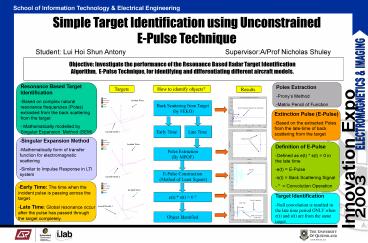Simple Target Identification using Unconstrained - PowerPoint PPT Presentation
1 / 1
Title:
Simple Target Identification using Unconstrained
Description:
Early Time: The time when the incident pulse is passing across the target. ... Based on the extracted Poles from the late-time of back scattering from the target ... – PowerPoint PPT presentation
Number of Views:22
Avg rating:3.0/5.0
Title: Simple Target Identification using Unconstrained
1
Simple Target Identification using Unconstrained
E-Pulse Technique
Student Lui Hoi Shun Antony Supervisor
A/Prof Nicholas Shuley
Objective Investigate the performance of the
Resonance Based Radar Target Identification
Algorithm, E-Pulse Technique, for identifying
and differentiating different aircraft models.
- Resonance Based Target Identification
- Based on complex natural resonance frequencies
(Poles) extracted from the back scattering from
the target - Mathematically modelled by Singular Expansion
Method (SEM)
- Poles Extraction
- Pronys Method
- Matrix Pencil of Function
How to identify objects?
Targets
Results
Incident Wave
Back Scattering from Target (by FEKO)
Back Scattering Signal from the Target
- Extinction Pulse (E-Pulse)
- Based on the extracted Poles from the late-time
of back scattering from the target
Late Time
Early Time
Late Time
Aircraft Model 1
Extracted Poles
- Singular Expansion Method
- Mathematically form of transfer function for
electromagnetic scattering - Similar to Impulse Response in LTI system
Incident Wave
- Definition of E-Pulse
- Defined as e(t) s(t) 0 in the late time
- e(t) E-Pulse
- s(t) Back Scattering Signal
- Convolution Operation
Poles Extraction (By MPOF)
E-Pulse
E-Pulse Construction (Method of Least Square)
Aircraft Model 2
- Early Time The time when the incident pulse is
passing across the target. - Late Time Global resonance occur after the pulse
has passed through the target completely.
Incident Wave
e(t) s(t) 0 ?
- Target Identification
- Null convolution is resulted in the late time
period ONLY when e(t) and s(t) are from the same
target.
Back Scattering
Late Time
Aircraft Model 3
Object Identified
Null Convolution at late time































